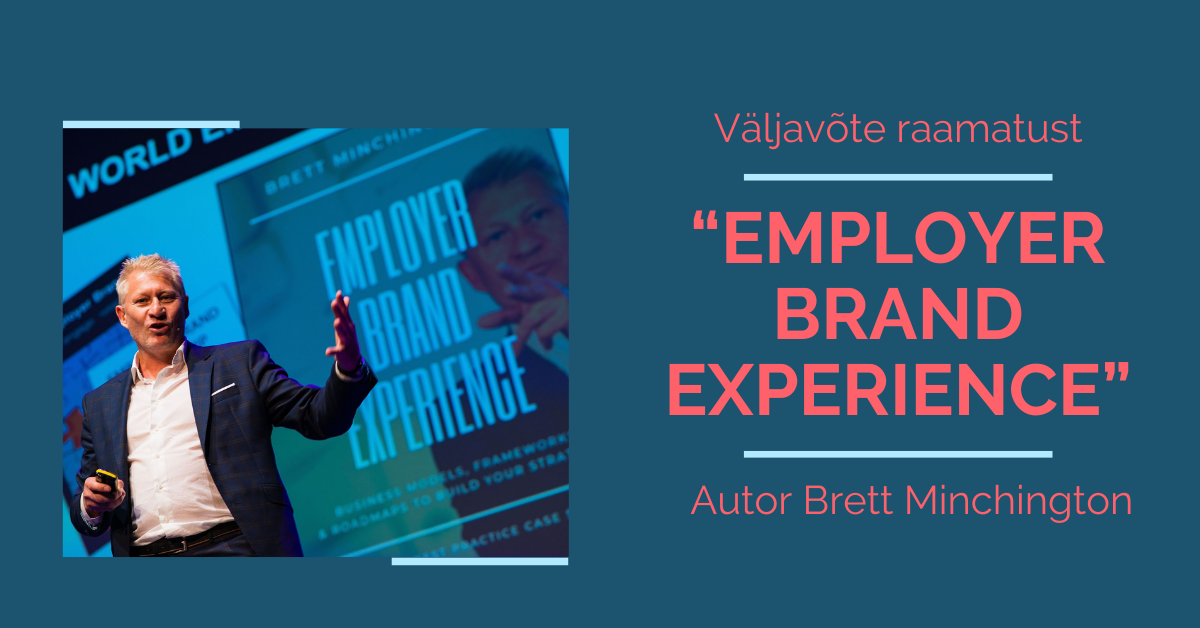Meil on hea meel avaldada väljavõte Brett Minchingtoni uusimast tööandja brändingu raamatust “EMPLOYER BRAND EXPERIENCE”. Brett toob rahvusvahelise tööandja brändingu meistriklassi esimest korda Eestisse juba 14. novembril!
Alles on jäänud vaid mõned piletid, kiirusta! See on kindlasti sündmus, mida ei tohiks mööda lasta personali-, kommunikatsiooni- ja turundusjuhid. Uuri lähemalt ja soeta pilet siit: https://instar.ee/brettminchington/
Employer branding has always been important. It’s just that more companies are investing in employer branding these days, not only by choice to stay ahead of their competitors, but most often because external market factors are making it more competitive to attract and retain the right talent at the right time. Around the world most industries are facing some kind of talent shortage, some more than others, such as IT, engineering and construction.
The current workforce climate is in a state of flux. There is a growing polarization of labour-market opportunities between high- and low-skill jobs, unemployment and underemployment, especially among young people, and stagnating incomes for a large proportion of households and income inequality.
Migration and its effects on jobs has become a sensitive political issue in many countries.
Combine this with the growth of the global freelancer market and more online channels for companies to share their stories and for candidates and employees to comment about their experiences, we now have a competitive landscape for talent we have never experienced before.
If companies think it is hard to find the best talent now, the lead up to 2025 is going to get really tough as the economic outlook in many countries is the best it has been in the past 10 years.
As a result, companies are set to increase their recruiting forecasts and candidates are much wiser now due to the growth of social media where they can discover what it’s like to work at a company, by the click of a mouse.
As Bill Gates once said, “We always overestimate the change that will occur in the next two years and underestimate the change that will occur in the next ten. Don’t let yourself be lulled into inaction.”
We now live in a world of economic uncertainty and an ever changing business landscape. This is the new reality of the new world of work. With somewhere around three billion people now working around the world, any major trends impacting the workplace will have consequences not only for organisations and their stakeholders, but for society. As social media networks continue to grow, so do concerns about their impact on society.
While social media has proven to be an excellent way for people to communicate and to be more aware of global affairs, it also has an unfortunate downside when people are bullied, causing many to suffer from mental health issues. Is being ‘always on,’ a good thing for the human race or is it a pathway toward something that will become increasingly hard for governments to regulate and result in outcomes far beyond what we ever imagined when we posted our first communication in social media?
This attention is likely to drive the social media giants to develop strategies to ensure their social responsibility is aligned with evolving community attitudes toward how and when these platforms are being used. At best, the downside may be damage to brands and profits, and at worst, their ultimate demise if they cannot find the right balance between society gains and financial profits.
Over the past 12 years as I have followed my passion for employer branding, talent acquisition and retention have become increasingly complex. Companies today face a multitude of challenges due to the changing landscape, including: the need for systems integration; embracing culture diversity; social and technological changes; jobless economic recoveries in many countries; the threat of declining fertility rates; ageing populations in many developed economies and an inequality in global education standards. These challenges show no signs of easing soon.
Today, the strains on the labour market are becoming increasingly apparent. In advanced economies, demand for high-skill labour is now growing faster than supply, while demand for low-skill labour remains weak. Labour’s overall share of income, or the share of national income that goes to worker compensation, has fallen, and income inequality is growing as lower-skill workers, including 71 million young people experience unemployment, underemployment, and stagnating wages.
The dynamics of the global labour market will make these challenges even more difficult. The population in China, as well as in many advanced economies, is ageing, reducing the growth rate of the global labour supply. Most of the additions to the global labour force will occur in India and the ‘young’ developing economies of Africa and South Asia. Ageing will likely add 360 million older people to the world’s pool of those not participating in the labour force, including 38 million college-educated workers, whose skills will already be in short supply.
Today, we live in an increasingly borderless world. The broad penetration of high-speed Internet has peeled away the barriers of time, distance and even language to create a global forum for the exchange of ideas and information. Interconnected and intelligent systems seamlessly link organisations and those that provide them with resources (e.g. employees, contractors, freelancers and on-demand workers) from every part of the world. Today, work can be easily performed across various cultures, geographies and time zones.
…………….Welcome to the new world of work!
